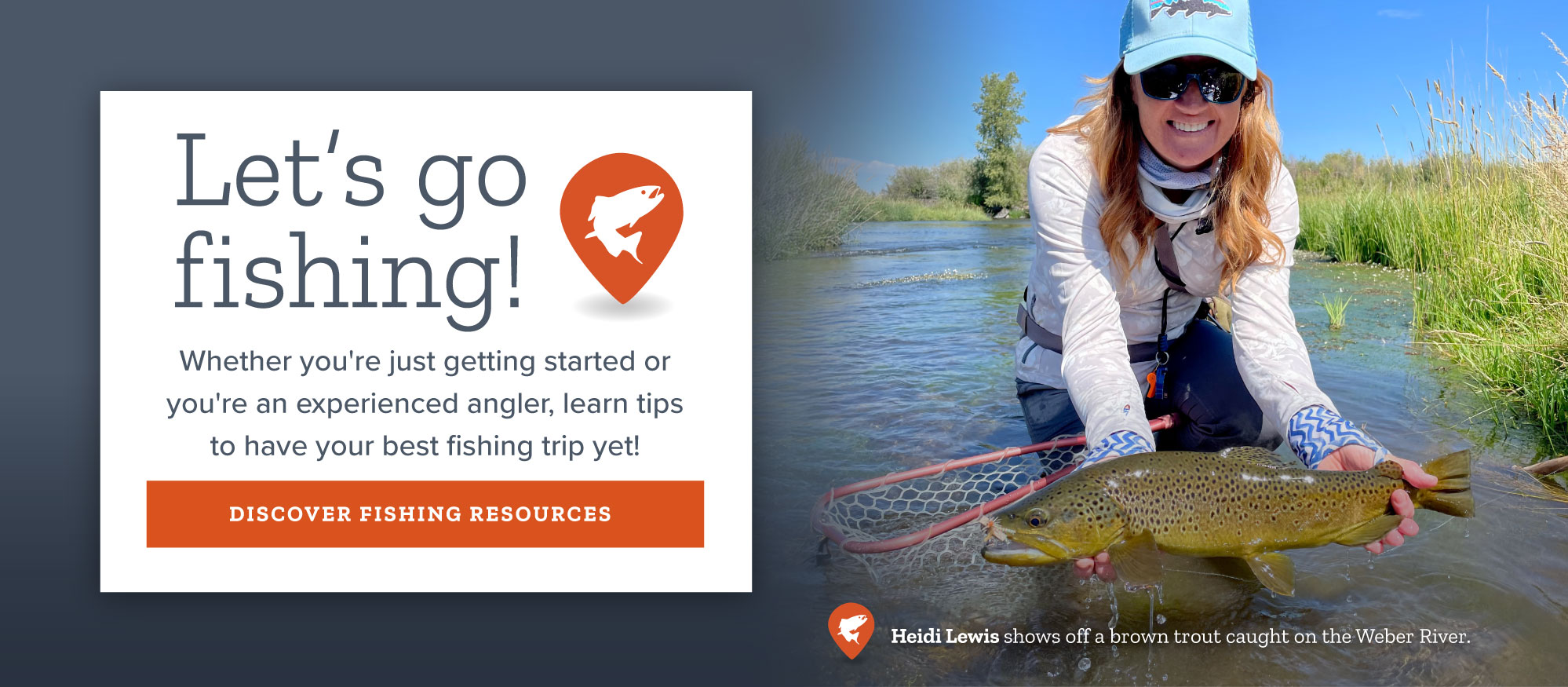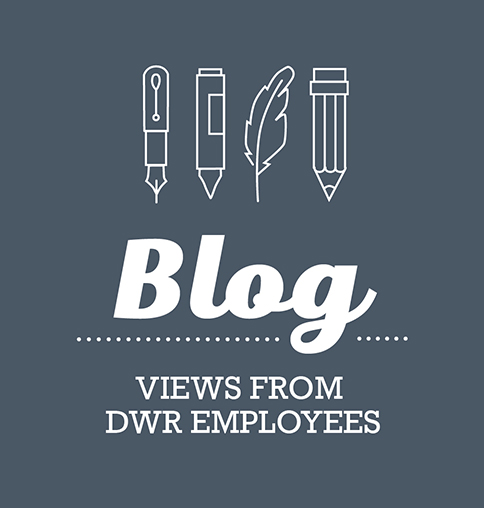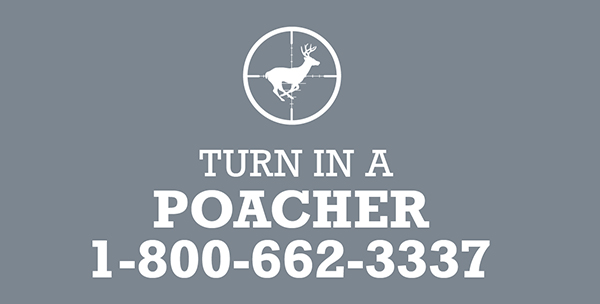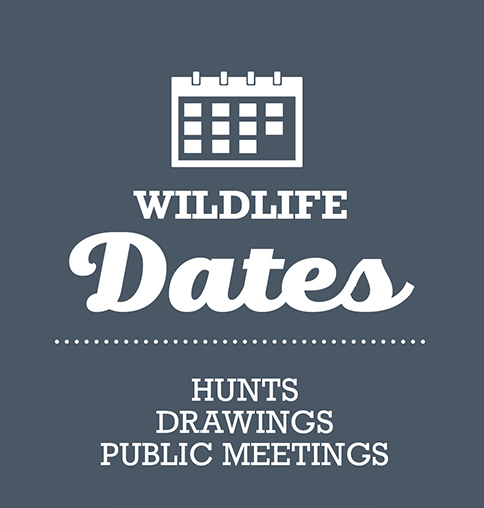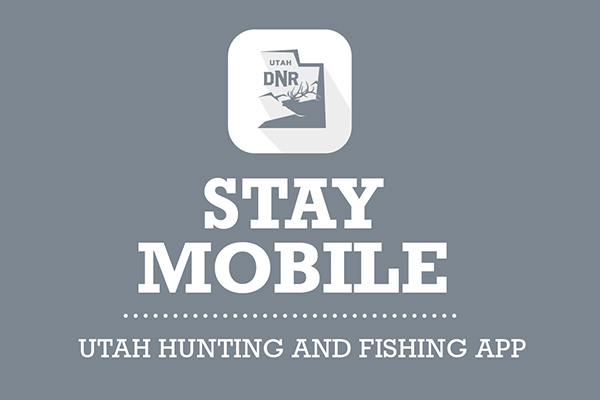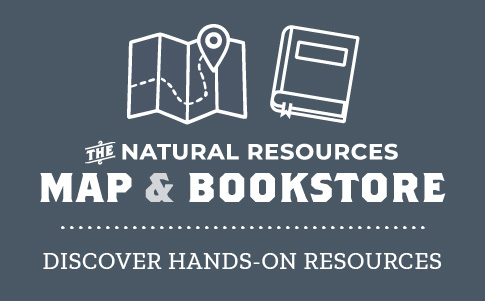Administrative rule R657-3c
Certification of registration — fish, mollusks and crustaceans
Scroll to bottom of page to view a menu of all administrative rules
KEY: wildlife, animal protection, import restrictions, zoological animals
Date of Last Change: October 1, 2023
Authorizing, and Implemented or Interpreted Law: 23A-2-304; 23A-2-305; 23A-5-309; 23A-5-305; 63G-7-101 et seq.
R657-3c-1. Purpose and Authority.
Under Title 23A, Wildlife Resources Code of Utah, this rule governs the collection, importation, possession and propagation of aquatic animals in Utah.
R657-3c-2. Definitions.
(1) Terms used for purposes of this rule are defined in Section 23A-1-101, Section R657-3a-2, and Subsection (2) through Subsection (10).
(2) "Aquaculture" means the husbandry, production, harvest, and use of aquatic organisms under controlled, artificial conditions.
(3) "Aquaculture facility" means any tank, canal, raceway, pond, off-stream reservoir or other structure used for aquaculture as defined under Title 4, Chapter 37, the Aquaculture Act and the rules promulgated there under.
(4) "Aquatic animal" means a member of any species of fish, mollusk or crustacean, including their eggs or sperm.
(5) "Baitfish" means aquatic animal species authorized for use as bait in Section R657-13-12.
(6) "Fee fishing facility" means a body of water used for holding or rearing fish to provide fishing for a fee or for pecuniary consideration or advantage as described in Title 4, Chapter 37, the Aquaculture Act.
(7) "Food fish" means aquatic animal species cultured or harvested from the wild for human consumption.
(8)(a) "Marine aquatic animal" means a member of any species of fish, mollusk or crustacean, including their eggs and sperm, that spends its entire life cycle in a marine environment.
(b) "Marine aquatic animal" does not include:
(i) anadromous aquatic animal species;
(ii) species that temporarily or permanently reside in brackish water; and
(iii) species classified as invasive or nuisance by state or federal law.
(9)(a) "Ornamental aquatic animal species" means any species of fish, mollusk or crustacean that is sold for display.
(b) "Ornamental aquatic animal species" does not mean:
(i) Sport fish;
(ii) Baitfish;
(iii) Aquatic animal species that are native to Utah;
(iv) Aquatic animals and marine aquatic animals prohibited for importation or possession under federal law; or
(v) Aquatic animals and marine aquatic animals listed as prohibited or controlled in Subsection R657-3c-5(1).
(10) "Sport fish" means aquatic animal species regulated for angling and harvest for recreation or sport from any state in the United States, excluding Peacock Bass (Cichla ocellaris).
R657-3c-3. Liability.
(1)(a) Any person who accepts a certificate of registration assumes all liability and responsibility for the collection, importation, transportation, possession and propagation of the authorized animal and for any other activity authorized by the certificate of registration.
(b) To the extent provided under the Title 63g, Chapter 7, the Governmental Immunity Act of Utah, the division, the Department of Agriculture and Food, and the Department of Health and Human Services shall not be liable in any civil action for:
(i) any injury, disease, or damage caused by or to any animal, person, or property as a result of any activity authorized under this rule or a certificate of registration; or
(ii) the issuance, denial, suspension, or revocation of or by the failure or refusal to issue, deny, suspend, or revoke any certificate of registration or similar authorization.
(2) It is the responsibility of any person who obtains a certificate of registration to read, understand and comply with this rule and all other applicable federal, state, county, city, or other municipality laws, regulations, and ordinances governing animals.
R657-3c-4. Prohibited Activities.
(1)(a) Except as provided in this rule, the rules of the Wildlife Board, including Section R657-13-12, Rule R657-14, and Rule R657-59, or Title 4, Chapter 37, the Aquaculture Act, noncontrolled, controlled or prohibited animals may not be released into the wild or any public or private waters without first obtaining authorization from the division.
(b) A violation of this section is punishable under Section 23A-5-305.
(c) A person may not release or transplant a live terrestrial or aquatic wildlife into the wild. A person who violates this subsection is guilty of a class A misdemeanor.
(d) A person who knowingly and without lawful authority imports, transports or releases a live species of wildlife that the person knows is listed as threatened or endangered, or is a candidate to be listed under the Endangered Species Act, 16 U.S.C. Sec. 1531 et seq., with the intent to establish the presence of that species in an area of the state not currently known to be occupied by a reproducing population of that species is guilty of a third degree felony.
(2) The division may seize or dispose of any illegally held animal.
(3)(a) Any peace officer, division representative, or authorized animal control officer may seize or dispose of any live animal that escapes from captivity.
(b) The division may retain custody of any recaptured animal until the costs of recapture or care have been paid by its owner or keeper.
R657-3c-5. Noncontrolled, Controlled and Prohibited Species.
(1)(a) The noncontrolled, controlled and prohibited aquatic animal species classification table entitled Aquatics Species Classification Table 3c-1, dated May 1, 2023 is incorporated by reference.
(b) Table 3c-1 can be accessed in person or by contacting the Salt Lake division office located at 1594 West North Temple, Salt Lake City, Utah 84114, and on the division's Certificates of Registration web page at https://wildlife.utah.gov/licenses/certificates-of-registration.html.
(2) A person may collect and possess live aquatic animals of controlled species if:
(a) They possess a valid certificate of registration;
(b) Successfully complete the Fish, Mollusk, and Crustacean education course;
(c) Satisfy the mandatory reporting requirements established in Section R657-3c-6; and
(d) The number of individuals of a species in a person's possession may not exceed the limits established under that person's certificate of registration.
(3) All native species and naturalized sportfish species are classified as controlled except those species that are classified as prohibited.
(4) Some species are classified as noncontrolled when stocked in a private fish pond, short-term fishing event, or aquaponics facility, as allowed in Rule R657-59.
(5) Triploid Grass Carp can be stocked as allowed in Rule R657-59.
(6)(a) Exemptions may be granted to educational, scientific, and commercial organizations.
(b) An individual or entity must acquire a certificate of registration before engaging in an educational, scientific, or commercial use activity involving the collection or possession of a controlled or prohibited species.
(i) A scientific use certificate of registration is valid for the time-period identified in the research proposal and approved by the division.
(ii) An educational use certificate of registration is valid for 3 years and authorize wildlife related instructional activities identified on the certificate of registration.
(iii) A commercial use certificate of registration is valid for 3 years and authorize commercial use activities identified on the certificate of registration.
R657-3c-6. Reporting Requirements for the Collection of Controlled Species.
(1) A person must report to the division within 72 hours of collecting a controlled species.
(2) Mandatory reporting must be completed using a division approved reporting platform, and shall include:
(a) Universal Transverse Mercator (UTM) or latitude/longitude coordinates of the collection point location;
(b) number of individuals or specimens collected;
(c) morphological measurements and descriptions of individuals or specimens; and
(d) photographic documentation.
(3) A person who fails to complete mandatory reporting as required in this rule may be:
(a) considered in unlawful possession of unreported animals; and
(b) deemed ineligible to obtain a certificate of registration for the collected species until such reporting is completed.
(4) Mandatory reporting for commercial use, scientific use, and educational use certificates of registration will be established as part of the certificate of registration approval process.
R657-3c-7. Application and Renewal Procedures — Fees — Expiration.
(1)(a) Initial and renewal applications for certificates of registration are available from, and must be submitted to, the Wildlife Registration Office in Salt Lake City or any regional division office.
(b) Applications may require a minimum of 45 days for review and processing from the date the application is received.
(c) Applications that are incomplete, completed incorrectly, or submitted without the appropriate fee or other required information may be returned to the applicant.
(2)(a) Upon or before the expiration date of a certificate of registration, the holder must apply for a renewal of the certificate of registration to continue the activity.
(b) The division may use the criteria provided in Section R657-3c-6 in determining whether to renew the certificate of registration.
(c) It is unlawful for a person to possess an animal for which a certificate of registration is required if that person;
(i) does not have a valid certificate of registration authorizing possession of the animal; or
(ii) fails to submit a renewal application to the division before the expiration of an existing certificate of registration authorizing possession of the animal.
(d) If a renewal application is not submitted to the division by the expiration date, live or dead animals held in possession under the expired certificate of registration shall be considered unlawfully held and may be seized by the division.
(e) If a renewal application is submitted to the division before the expiration date of the existing certificate of registration, continued possession of the animal under the expired certificate of registration shall remain lawful while the renewal application is pending.
(3)(a) Certificates of registration are not transferable and expire December 31 of the year issued, except as otherwise designated on the certificate of registration.
(b) If the holder of a certificate of registration is a representative of an institution, organization, business, or agency, the certificate of registration shall expire effective upon the date of the representative's discontinuation of association with that entity.
(c) Certificates of registration do not provide the holder any rights of succession and any certificate of registration issued to a business or organization shall be void upon the termination of the business or organization or upon bankruptcy or transfer or death of the certificate of registration holder.
(4) Failure to submit timely, accurate or valid reports as required under this rule or the terms of a certificate of registration may disqualify a person from renewing an existing certificate of registration or obtaining a new certificate of registration.
R657-3c-8. Issuance and Renewal Criteria.
(1) The following factors shall be considered before the division may issue or renew a certificate of registration for the collection, importation, transportation, possession or propagation of an animal:
(a) the health, welfare, and safety of the public;
(b) the health, welfare, safety, and genetic integrity of wildlife, domestic livestock, poultry, and other animals;
(c) ecological and environmental impacts;
(d) the suitability of the applicant's holding facilities;
(e) the experience of the applicant for the activity requested; and
(f) ecological or environmental impact on other states.
(2) In addition to the criteria provided in Subsection (1), the division shall use the following criteria for the issuance or renewal of a certificate of registration for a scientific use of an animal;
(a) the validity of the objectives and design;
(b) the likelihood the project will fulfill the stated objectives;
(c) the applicant's qualifications to conduct the research, including education or experience;
(d) the adequacy of the applicant's resources to conduct the study; and
(e) whether the scientific use is in the best interest of the animal, wildlife management, education, or the advancement of science without unnecessarily duplicating previously documented scientific research.
(3) In addition to the criteria provided in Subsection (1), the division may use the following criteria for the issuance or renewal of a certificate of registration for an educational use of an animal:
(a) the objectives and structure of the educational program;
(b) whether the applicant has written approval from the appropriate official if the activity is conducted in a school or other educational facility: and
(c) whether the individual is in possession of the required federal permits.
(4) The division may deny issuing or renewing a certificate of registration to any applicant, if:
(a) the applicant has violated Title 23A, the Wildlife Resources Code of Utah, Title R657, proclamation or guidebook, a certificate of registration, an order of the Wildlife Board or any other law that when considered with the functions and responsibilities of collecting, importing, possessing or propagating an animal bears a reasonable relationship to the applicant's ability to safely and responsibly carry out such activities;
(b) the applicant has previously been issued a certificate of registration and failed to submit any report or information required by this rule, the division, or the Wildlife Board;
(c) the applicant misrepresented or failed to disclose material information required in connection with the application; or
(d) holding the animal at the proposed location violates federal, state, or local laws.
(5) The collection or importation and subsequent possession of an animal may be granted only upon a clear demonstration that the criteria established in this section have been met by the applicant.
(6) The division, in making a determination under this section, may consider any available facts or information that is relevant to the issuance or renewal of the certificate of registration, including independent inquiry or investigation to verify information or substantiate the qualifications asserted by the applicant.
(7) If an application is denied, the division shall provide the applicant with written notice of the reasons for denial.
R657-3c-9. Collection of Aquatic Animal Species.
(1) A person shall obtain a certificate of registration before collecting any aquatic animal species or aquatic animal species parts classified as prohibited or controlled, except as otherwise provided in this rule, statute or rules and orders of the Wildlife Board.
(2) A certificate of registration is not required to collect any aquatic animal species classified as noncontrolled.
R657-3c-10. Importation of Aquatic Animal Species.
(1)(a) A person shall obtain a certificate of registration before importing any aquatic animal species or aquatic animal species parts classified as prohibited or controlled, except as otherwise provided in this rule, statute or rules and orders of the Wildlife Board.
(b) A person shall provide the Division copies of U.S. Fish and Wildlife Service form 3-177, upon request, for ornamental aquatic animal species imported from outside the United States.
(c) A person shall have the U.S. Fish and Wildlife Service import license number for the entity that imported ornamental aquatic animal species in their possession.
(2) A certificate of registration is not required to import any aquatic animal species classified as noncontrolled.
(3)(a) All live aquatic animals, including marine aquatic animals, imported into Utah and not destined for an aquaculture facility or fee fishing facility must be accompanied by the following documentation:
(i) common or scientific names of the aquatic animals;
(ii) name and address of the consignor and consignee;
(iii) origin of shipment;
(iv) final destination;
(v) number of aquatic animals shipped; and
(vi) certificate of veterinary inspection, Utah entry permit number issued by the Utah Department of Agriculture and Food, and any other health certifications.
(b) A person may import live fish destined for an aquaculture facility or fee fishing facility only as provided by Title 4, Chapter 37, the Aquaculture Act and the rules promulgated there under.
(4) Subsection (1) does not apply to dead fish or crayfish caught in Lake Powell, Bear Lake, or Flaming Gorge reservoirs under the authority of a valid fishing license and in accordance with Rule R657-13 and the proclamation of the Wildlife Board for taking fish and crayfish.
(5) Any water used to hold or transport fish shall not be emptied into a stream, lake, or other natural body of water.
R657-3c-11. Transportation of Aquatic Animal Species.
(1) A person shall obtain a certificate of registration before transporting any aquatic animal species or aquatic animal species parts classified as prohibited or controlled, except as otherwise provided in this rule, statute or rules and orders of the Wildlife Board.
(2) A certificate of registration is not required to transport any aquatic animal species classified as noncontrolled.
R657-3c-12. Possession of Aquatic Animal Species.
(1) A person shall obtain a certificate of registration before possessing any aquatic animal species or aquatic animal species parts classified as prohibited or controlled, except as otherwise provided in this rule, statute or rules and orders of the Wildlife Board.
(2) A certificate of registration is not required to possess any aquatic animal species classified as noncontrolled.
R657-3c-13. Propagation of Aquatic Animal Species.
(1) A person shall obtain a certificate of registration before propagating any aquatic animal species classified as prohibited or controlled, except as otherwise provided in this rule, statute, or rules and orders of the Wildlife Board.
(2) A certificate of registration is not required to propagate any aquatic animal species classified as noncontrolled.
R657-3c-14. Brine Shrimp and Brine Shrimp Eggs.
(1) A certificate of registration is not required to collect, transport, or possess brine shrimp and brine shrimp eggs for personal use, provided:
(a) the brine shrimp and brine shrimp eggs are collected, transported, and possessed together with water in a container no larger than one gallon;
(b) no more than a one gallon container of brine shrimp and brine shrimp eggs, including water, is collected during any consecutive seven day period; and
(c) the brine shrimp or brine shrimp eggs following possession are not released live into the Great Salt Lake, Sevier River, or any of their tributary waters.
Except otherwise listed, all species are presumed prohibited. All species not listed will require an assessment before collection, importation or possession will be authorized.
| Noncontrolled fishes, mollusks and crustaceans | ||
|---|---|---|
| Common name | ||
| Any ornamental aquatic animal species except those classified as prohibited | ||
| Any marine aquatic animal species except those classified as prohibited | ||
| Controlled fishes | ||
|---|---|---|
| Common name | Scientific classification | Comments |
| Bear Lake sculpin | Cottus extensus | |
| Bear Lake whitefish | Prosopium abyssicola | |
| Black crappie | Pomoxis nigromaculatus | |
| Bluegill | Lepomis macrochirus | |
| Bluehead sucker | Catostomus discobolus | |
| Bonneville cisco | Prosopium gemmifer | |
| Bonneville whitefish | Prosopium spilonotus | |
| Brook trout | Salvelinus fontinalis | |
| Brown trout | Salmo trutta | |
| Bullhead (all species) | Ameiurus sp | |
| Channel catfish | Ictalurus punctatus | |
| Common carp | Cyprinus carpio | |
| Cutthroat trout | Oncorhynchus clarkii | |
| Desert sucker | Catostomus clarkii | |
| Fathead minnow | Pimephales promelas | |
| Flannelmouth sucker | Catostomus latipinnis | |
| Lake trout | Salvelinus namaycush | |
| Largemouth bass | Micropterus salmoides | |
| Least chub | Lotichthys phlegethontis | |
| Longnose dace | Rhinichthys cataractae | |
| Mottled sculpin | Cottus bairdii | |
| Mountain sucker | Catostomus platyrhynchus | |
| Mountain whitefish | Prosopium williamsoni | |
| Northern leatherside chub | Lepidomeda copei | |
| Northern pike | Esox lucius | |
| Paiute sculpin | Cottus beldingii | |
| Rainbow trout | Oncorhynchus mykiss | |
| Redside shiner | Richardsonius balteatus | |
| Roundtail chub | Gila robusta | |
| Smallmouth bass | Micropterus dolomieu | |
| Southern leatherside chub | Lepidomeda aliciae | |
| Speckled dace | Rhinichthys osculus | |
| Splake trout | Salvelinus namaycush x Salvelinus fontinalis | |
| Striped bass | Morone saxatilis | |
| Tiger muskellunge | Esox masquinongy x Exox lucius | |
| Tiger trout | Salmo trutta x Salvelinus fontinalis | |
| Utah chub | Gila atraria | |
| Virgin spinedace | Lepidomeda mollispinis | |
| Walleye | Sander vitreus | |
| Western mosquitofish | Gambusia affinis | |
| White bass | Morone chrysops | |
| White crappie | Pomoxis annularis | |
| Wiper | Morone saxatilis x Morone chrysops | |
| Yellow perch | Perca flavescens | |
| Prohibited fishes | ||
|---|---|---|
| Common name | Scientific classification | Comments |
| Alewife | Alosa pseudoharengus | |
| Asian swamp eel | Monopterus albus | |
| Bighead carp | Hypophthalmichthys nobilis | |
| Black carp | Mylopharyngodon piceus | |
| Bonytail | Gila elegans | |
| Bowfin | Amia calva | |
| Brook stickleback | Culaea inconstans | |
| Burbot | Lota lota | |
| Colorado pikeminnow | Ptychocheilus lucius | |
| Eurasian ruffe | Gymnocephalus cernuus | |
| Flathead catfish | Pylodictis olivaris | |
| Gar | Family Lepisosteidae | All species |
| Grass carp (diploid) | Ctenopharyngodon idella | Triploid grass carp classified as controlled |
| Humpback chub | Gila cypha | |
| Ide | Leuciscus idus | |
| June sucker | Chasmistes liorus | |
| Piranhas (all species) | Genus Catoprion, genus Pristobrycon, genus Pygocentrus, genus Pygopristis and genus Serrasalmus | All species |
| Nile perch | Lates niloticus | |
| Northern snakehead | Channa argus | |
| Razorback sucker | Xyrauchen texanus | |
| Red bellied pacu | Piaractus brachypomus | |
| Red shiner | Cyprinella lutrensis | |
| Round goby | Neogobius melanostomus | |
| Rudd | Scardinius erythrophthalmus | |
| Sand shiner | Notropis stramineus | |
| Sea lamprey | Petromyzon marinus | |
| Silver carp | Hypophthalmichthys molitrix | |
| South American parasitic catfish | Family Cetopsidae and family Trichomycteridae | All species |
| Tiger fish | Hydrocynus vittatus | |
| Tench | Tinca tinca | |
| Tilapia | Genus Coelotilapia, genus Coptodon, genus Heterotilapia, genus Oreochromis and genus Sarotherodon | All species |
| Virgin River chub | Gila seminuda | |
| Walking catfish | Clarias batrachus | |
| Woundfin | Plagopterus argentissimus | |
| Zander | Sander lucioperca | |
| All fish species that are not listed as noncontrolled, controlled or prohibited are presumed prohibited. | ||
| Controlled mollusks | ||
|---|---|---|
| Common name | Scientific classification | Comments |
| Ambersnails | Genus Oxiloma, genus Catinella and genus Succinea | All species |
| Brown hive | Euconulus fulvus | |
| Collumns and daggers | Genus Columella, genus Pupilla and genus Pupoides | All species |
| Creeping ancylid | Ferrissia rivularis | |
| Desert tryonia | Tryonia porrecta | |
| Freshwater clams | Genus Musculium, genus Pisidium and genus Sphaerium | All species |
| Gems | Genus Hawaiia and genus Ogaridaiscus | All species |
| Glass snails | Genus Glyphyalinia and genus Nesovitrea | All species |
| Glosses | Genus Zonitoides | All species |
| Green River pebblesnail | Fluminicola coloradensis | |
| Mexican coil | Helicodiscus eigenmanni | |
| Mountain snails | Genus Oreohelix | All species |
| Mud Amnicola | Amnicola limosus | |
| Physas | Genus Aplexa, genus Physa and genus Physella | All species |
| Rams-horns and gyros | Genus Gyraulus, genus Helisoma, genus Menetus, genus Planorbella and genus Promentus | All species |
| Rocky Mountain duskysnail | Colligyrus greggi | |
| Small spot disks | Genus Disk | All species |
| Snagletooths and vertigo | Genus Gastrocopta and genus Vertigo | All species |
| Springsnails | Genus Pyrgulopsis | All species |
| Valvatas | Genus Valvata | All species |
| Western glass-snail | Vitrina pellucida | |
| Western pearlshell | Margaritifera falcata | |
| Floater | Genus Anodonta | All species |
| Pondsnails and marshsnails | Genus Galba, genus Lymnaeasp and genus Stagnicola | All species |
| Spruce snail | Microphysula ingersolli | |
| Vallonias | Genus Vallonia | All species |
| Prohibited mollusks | ||
|---|---|---|
| Common name | Scientific classification | Comments |
| Asian clam | Corbicula fluminea | |
| Channeled apple snail | Pomacea canaliculata | |
| Brown garden snail | Cornu asperum | |
| Cellar glass-snail | Oxychilus cellarius | |
| Chinese mystery snail | Cipangopaludina chinensis | |
| Decollate snail | Rumina decollata | |
| Faucet snail | Bithynia tentaculata | |
| Giant floater | Pyganodon grandis | |
| Giant gardenslug | Limax maximus | |
| Golden mussel | Limnoperna fortunei | |
| Gray fieldslug | Deroceras reticulatum | |
| New Zealand mud snail | Potamopyrgus antipodarum | |
| Paper pondshell | Lymnaea stagnalis | |
| Quagga mussel | Dreissena rostriformis | |
| Red-rimmed melania | Melanoides tuberculata | |
| Southern flatcoil | Polygyra cereolus | |
| Veined rapa whelk | Rapana venosa | |
| Zebra mussel | Dreissena polymorpha | |
| All mollusk species that are not listed as noncontrolled, controlled or prohibited are presumed prohibited. | ||
| Controlled crustaceans | ||
|---|---|---|
| Common name | Scientific classification | Comments |
| Brine shrimp | Genus Artemia | All species |
| Northern (virile) crayfish | Faxonius virilis | |
| Pilose crayfish | Pacifastacus gambelii | |
| Prohibited crustaceans | ||
|---|---|---|
| Common name | Scientific classification | Comments |
| Asian shore crab | Hemigrapsus sanguineus | |
| Chinese mitten crab | Eriocheir sinensis | |
| European green crab | Carcinus maenas | |
| Fishook water flea | Cercopagis pengoi | |
| Killer shrimp | Dikerogammarus villosus | |
| Marbled crayfish | Procambarus virginalis | |
| Marron crayfish | Cherax tenuimanus | |
| Redclaw crayfish | Cherax quadricarinatus | |
| Rusty crayfish | Orconectes rusticus | |
| Signal crayfish | Pacifastacus leniusculus | |
| Spiny water flea | Bythotrephes longimanus | |
| Yabby crayfish | Cherax destructor | |
| All crustacean species that are not listed as noncontrolled, controlled or prohibited are presumed prohibited. | ||
